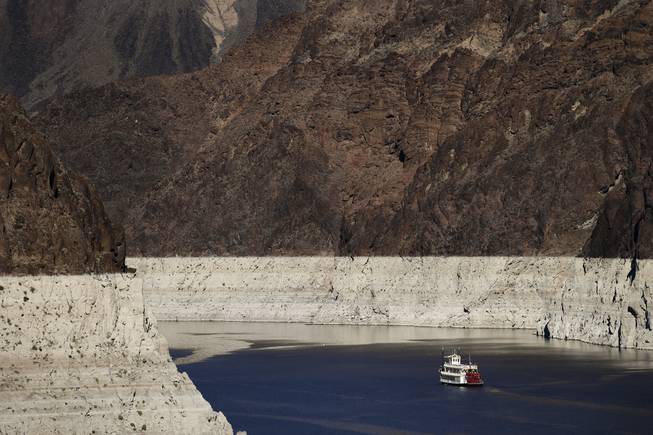
Jae C. Hong / AP
In this Oct. 14, 2015, file photo, a riverboat glides through Lake Mead on the Colorado River at Hoover Dam near Boulder City.
Thursday, Feb. 23, 2017 | 2 a.m.
Hot weather related to long-term climate change has been a prime cause of this century's chronic shortfalls in Colorado River flows, a new study says.
This is the first study to formally link climate change to the river's declining flows, said the researchers, Jonathan Overpeck of the University of Arizona and Bradley Udall of Colorado State University. The river provides drinking water to between 35 million and 40 million people in seven Western states, including Arizona.
Lake Mead, a key reservoir of Colorado River water, dropped steadily from 2000 through 2014, after being nearly full in 2000. Average annual river flows in that period were 19.3 percent below their 20th-century average, the study found.
Less precipitation was part of the river's problems. But temperature increases averaging 1.6 degrees Fahrenheit above normal in the river's Upper Basin caused one-sixth to one-half of the river's dramatic flow declines, the researchers wrote.
The hotter weather stripped the river of at least 500,000 acre-feet of water, Overpeck and Udall said. That's enough to serve half a million families of four for a year, according to the U.S. Bureau of Reclamation, based on regional water use rates. The same amount of water would go much further in Tucson, whose households use far less water than many other Western cities.
The study appeared online in Water Resources Journal, published by the American Geophysical Union.
The researchers contrasted the 2000-14 drought on the river with another one that lasted from the middle 1950s to about 1967. That time, precipitation fell sharply. It fell less sharply this time around, and this time, heat was a much bigger factor in reducing river flows, they said.
Looking ahead, the researchers say continued warming weather is likely to reduce river flows far more than federal water managers have predicted for the rest of the 21st century.
The Bureau of Reclamation released a report in 2012 saying river flows would decline by an average of 9 percent by mid-century compared to their 20th century average.
Overpeck and Udall predict declines of 20 percent to 30 percent by mid-century and 35 to 55 percent by 2100, if global greenhouse gas emissions continue at their current pace or are reduced only slightly.
Bureau officials didn't respond to requests from the Star for comment on the new study.
Two researchers not involved with the study, Connie Woodhouse of the University of Arizona and Dennis Lettenmaier at UCLA, agreed with at least some of its conclusions.
A third, meteorologist Martin Hoerling of the National Oceanic and Atmospheric Administration, criticized the study's forecasts of future precipitation. He also said it didn't adequately account for precipitation's impacts on the last 15 years of river flows.
Udall's view is that the recent 20 percent reduction is likely to be "the new flow regime on the river."
"The good news is you still have 80 percent of the river left. The bad news is we get to throw out our 20th century rules for managing water," said Udall, a researcher at CSU's Colorado Water Institute.
To predict future flows, the researchers separated the impacts of what they say are "certain" temperature increases due to climate change from the impacts of what they said are far more uncertain changes in rainfall and snowpack.
Overpeck, director of the UA's Institute for the Environment, contrasted that with the Bureau of Reclamation's forecasting. The bureau simply averaged the results of all known climate change models for the river basin, assuming that all precipitation forecasts have an equally likely chance of occurring, he said.
While more precipitation could ease warmer weather's impacts, "there's no good science to tell us that will happen," Udall said. To compensate for warming, "gigantic" precipitation increases that haven't been forecast would be needed, Overpeck said.
NOAA's Hoerling, however, said the most recent computer models used by the reclamation agency indicate the majority of projections are for wetter cold seasons in the Colorado River headwaters -- perhaps at least 10 percent more. That can translate to a 20 percent increase in runoff, enough to compensate for even significant temperature increases, he said.
He said the new study took a "crude" approach to estimating precipitation declines' impact on 2000-14 river flows. The study didn't take into account the times of the year and the locations where actual precipitation shortfalls occurred, he said.
"It's also important to note that during drought, temperatures are usually high. So it's not likely that all of the warmth in the 2000-14 period is a climate change symptom," Hoerling said.
The UA's Woodhouse, however, said she has high confidence that rising future temperatures will impact runoff. "Regardless of precipitation amounts, the annual streamflow will be less than it would be under average 20th-century temperatures," she said.
"A 1950s drought under today's temperatures will be longer and more severe, overall," said Woodhouse, a professor in the UA's School of Geography and Development. "If and when wet conditions return to the Upper Colorado River Basin, the effectiveness of these wet conditions will be diminished, in terms of the resulting streamflow, relative to wet periods in the past."

Join the Discussion:
Check this out for a full explanation of our conversion to the LiveFyre commenting system and instructions on how to sign up for an account.
Full comments policy